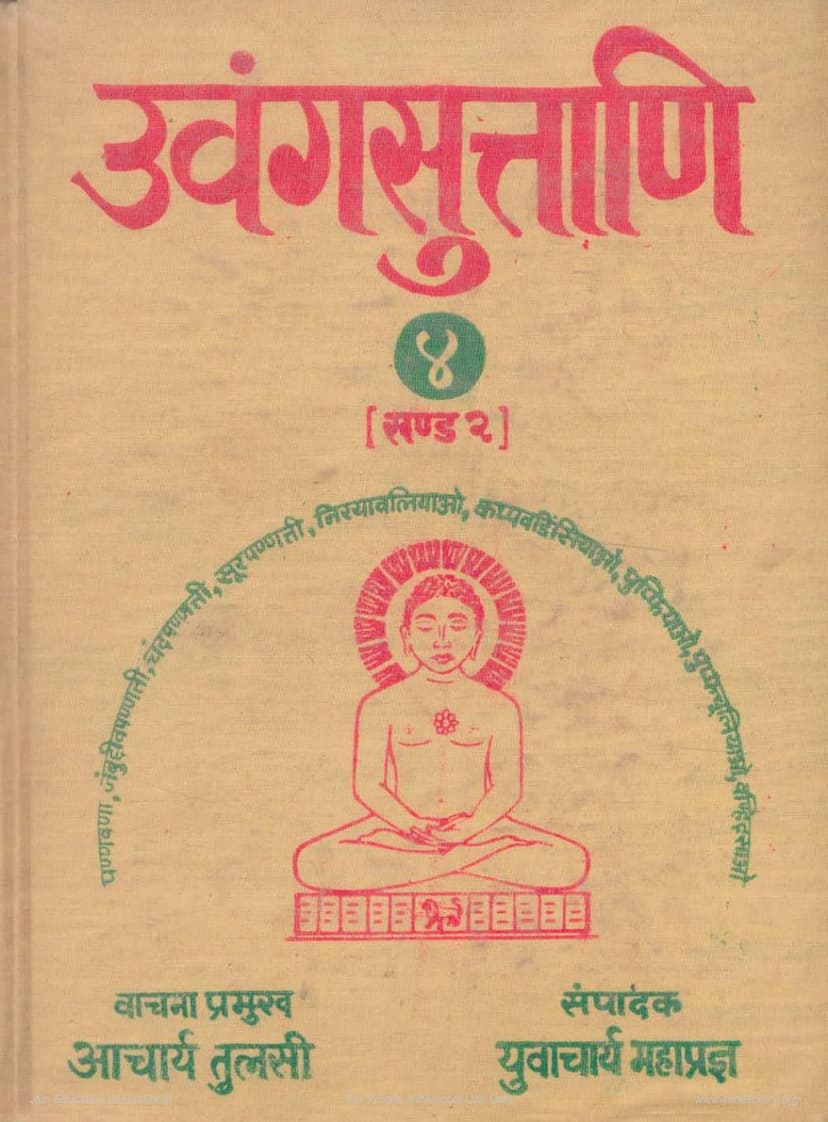Agam 23 Upang 12 Vrashnidasha Sutra Vanhidasao Terapanth
Added to library: September 1, 2025

Summary
Here's a comprehensive summary of the Jain text "Agam 23 Upang 12 Vrashnidasha Sutra Vanhidasao" based on the provided information:
Book Title: Agam 23 Upang 12 Vrashnidasha Sutra Vanhidasao Author(s): Acharya Tulsi (Vachana Pramukh), Acharya Mahapragna (Sampadak) Publisher: Jain Vishva Bharati, Ladnun (Rajasthan) Publication Year: Vikram Samvat 2045 (1989 A.D.) / 1986 A.D. (mentioned on page 3) Catalog Link: https://jainqq.org/explore/003579/1
Overview:
This volume, titled "Uvangasuttani (Khand 2)" or "Uvangasuttāni IV (Part II)", is a significant publication by Jain Vishva Bharati, dedicated to the critical editing and publication of Jain Agamas. It represents a monumental effort to bring out the original texts of these ancient scriptures, along with variant readings and comprehensive indices, making them accessible to scholars and researchers. This particular volume focuses on the Upangas, which are subsidiary texts to the main Angas in Jain canon.
Content of this Volume:
This volume specifically contains nine Upangas:
- Paṇṇavaṇā (Prajñāpanā): The first Agama mentioned.
- Jambudīvapaṇṇatti (Jambūdvīpaprapti): The second Agama.
- Candapannatti (Candraprajñapti): The third Agama.
- Sūrapannatti (Sūryaprajñapti): The fourth Agama.
- Nirayāvaliyāō (Nirayāvalikā): The fifth Agama.
- Kappavadiṁsiyāo (Kalpavātika): The sixth Agama.
- Puṁphiyāo (Puṣpīyā): The seventh Agama.
- Puṁphacūliyāo (Puṣpacūlikā): The eighth Agama.
- Vanhidasāo (Vṛṣṇidaśā): The ninth Agama.
These nine Upangas, along with the three Upangas published in "Uvangasuttāni, Part 4, Volume 1" (Ovaīyaṁ, Rāyapaseṇiyaṁ, and JīvāJīvābhigame), complete the publication of the thirty-two Āgamas within the "Agam-Sutta Granthamala" series.
Editorial and Publication Philosophy:
- Comprehensive Series: Jain Vishva Bharati embarked on a multi-faceted plan for Agama publication, including:
- Agam-Sutta Granthamala: Original text with variant readings, word indices, etc. (this volume belongs here).
- Agam-Anusandhan Granthamala: Original text with Sanskrit translation, index, critical notes.
- Agam-Anushilan Granthamala: Critical studies of Agamas.
- Agam-Katha Granthamala: Collection and translation of stories from Agamas.
- Vargikrut-Agam Granthamala: Classified summaries of Agamas.
- Agam Hindi Translation Series: Hindi translations only.
- Leadership and Collaboration: The project was initiated by Acharya Tulsi, with Acharya Mahapragna as the chief editor and reviewer. Numerous monks and nuns collaborated in the text purification, word indexing, and proofreading, highlighting a significant collective effort.
- Textual Fidelity: The editors consulted multiple manuscript copies and commentaries, aiming for textual purity and critical accuracy. They acknowledged the challenges of editing ancient texts with linguistic and conceptual evolution.
- Dedication and Vision: The publication reflects a long-standing vision and arduous effort to preserve and propagate Jain scriptural knowledge. The introduction by Acharya Tulsi expresses deep satisfaction and gratitude for the successful completion of this phase of the Agama publication.
- Financial Support: The publication was made possible by the munificence of various individuals and trusts, including Shri Ramlal Hansraj Golchha of Viratnagar and the Mitra Parishad of Calcutta, which supported the Jain Vishva Bharati Press.
Key Insights from the Introductions and Content:
- Pannavaṇā: This Upanga is described as an "ocean of Tattva-vidya" (science of reality), elaborating on the two fundamental substances: soul (jiva) and non-soul (ajiva). It contains classifications of beings, including a unique depiction of collectivism through "sadharanashariri" (common-bodied beings) and discussions on Aryan and Mleccha concepts. It's considered a source book for Tattva-jnana and its content is largely integrated into the Bhagavati Sutra by Devarddhigani. The author is identified as Arya Shyam, a disciple of Shudharmaswami, who lived in the 4th century of Mahavira Nirvana.
- Jambuddivapaṇṇatti: This Agama focuses on Jambudvīpa, detailing its geography and cosmology. It mentions Lord Rishabha, Kulakaras, Bharata Chakravarti, the cycle of time, and the solar system. The description of the current Avasharpini's sixth era is noted for its harrowing depiction that resonates with the horrors of nuclear war. It also highlights the similarities between Lord Rishabha and Lord Mahavira. The work is divided into seven "Vakshaskaras." Its composition is believed to be post-Mahavira's Nirvana, with an unknown author, possibly from the 4th-5th century of Vira Nirvana.
- Candapannatti and Sūrapannatti: These are mentioned as two separate Āgamas in ancient lists, with Candraprajñapti being considered Kalika and Sūryaprajñapti Utkalika. However, their complete texts are not available, and current manuscripts often have identical content, leading to speculation that Candraprajñapti might have begun after the 10th chapter of Sūryaprajñapti. Both are commented upon by Malayagiri.
- Nirayāvaliyāo and the Five Classes: The text explains that the term "Upanga" is a collection of five types of Āgamas, with Nirayāvalikā being the first. The other four are Kalpasikā, Pushpikā, Pushpacūlikā, and Vṛṣṇidaśā. It notes that the term "Upanga" itself was not mentioned in the Nandi Sutra, suggesting a later compilation of these five into a single Śrutaskandha. Nirayāvalikā's subject matter revolves around auspicious and inauspicious conduct, karma, and their consequences, with specific descriptions of battles, the salvation of princes, the worship and violation of asceticism, and the lives of disciples. The author and date are uncertain, but it references other Angas like Bhagavati and Upāsakadaśā.
- Vanhidasāo (Vṛṣṇidaśā): This is the ninth Upanga discussed, with twelve chapters, providing narratives related to the Vṛṣṇi dynasty.
Significance:
The publication of this volume is a landmark achievement in the field of Jain Agama studies. It represents the culmination of years of dedicated effort by Acharya Tulsi, Acharya Mahapragna, and their dedicated team, fulfilling a crucial need for authentic, critically edited Jain texts. The comprehensive word index appended is particularly valuable for scholars engaged in deep textual research.
This summary aims to capture the essence of the provided text, highlighting the key Agamas included, the editorial approach, and the rich content discussed within the introductions and the texts themselves.